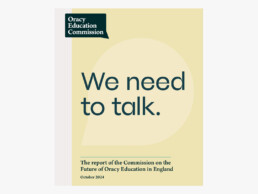Reflections on the Oracy Education Commission Report
This is long for a blog but it felt essential to include some of the highly significant quotes found throughout the report.
The Oracy Education Commission Report was released on Tuesday 8th October to a wide and eagerly awaiting audience. Many schools and senior leaders are still growing and developing their understanding of what oracy actually is and the implications for future teaching and classroom practice. Many consultants, like myself, and presumably also many academics, were wondering whether the findings of the commission would support or conflict with already formed opinions and recommendations. We need not have worried. The report is a liberal summation of the opinions and findings of the majority and there is little to conflict or negate authentic existing practice.
There are, however, just three areas I would appreciate further clarification and possibly exploration around. They are the matters of the definition of:
- What is oracy?
- Why should oracy be actually taught pro-actively in schools?
- How should that be done for the best outcomes for children?
The answers to these questions will then inform the decisions and future actions of teacher trainers and school leaders as they move forward to address this sensitive but vital inclusion in the curriculum – the fourth R!
Let me open by listing the many aspects of the report that I found particularly encouraging, reassuring or even exciting, and express the few concerns I have as I go along.
A huge strength of the report is the frequent inclusion of the words of actual teaching practitioners on many levels, and – for me in my work – the thoroughness and creativity with which so many primary practitioners are empowering pupils in the gift of choice is both moving and humbling. As teachers, it is not our job to challenge the opinions of linguists, but many of us do keep abreast with the world of academia to strengthen our beliefs and for confirmation and justification. I particularly valued:
Oracy education should [..include] learning about talk, particularly the sociolinguistics of code-switching, to raise awareness of the validity of effective communication in multiple spoken Englishes. THE ENGLISH ASSOCIATION, WRITTEN EVIDENCE TO THE COMMISSION (P18)
I loved the statement at the opening of the report that:
There is very strong evidence that oracy education helps children in learning to, through and about talk, listening and communication. (P5)
This is not, in itself, a definition but is rather a statement of fact that justifies the opinion that oracy must become the fourth R, on a parallel with reading, writing and arithmetic. On pages 14 and 28, the report provides its definition of oracy saying that:
Oracy is: articulating ideas, developing understanding and engaging with others through speaking, listening and communication.
My personal research and opinions remain that oracy is this and so much more than this – and also so much less! The report appears to define oracy as the general aim of talk and communication rather than as a specific – that is the process towards oration and oratory. It identifies, in the need for change:
To realise the promise of oracy education, we need to adopt a shared definition and common understanding of what oracy is, and where to locate it in our education ecosystem. (P18)
I do so agree with this and feel there is more work to do in this area as we are not quite there yet.
The quoting of Sir Robin Alexander, whose inspirational work on dialogic teaching failed to create the impact and change that it deserved, which would have seen the initiation of the implementation of oracy through an alternative approach, was pleasing.
Dialogic teaching is a ‘pedagogy of the spoken word which harnesses the power of talk to stimulate and extend students’ thinking, learning, knowing and understanding, and to enable them to discuss, reason and argue. (P15)
Oracy also aspires to ‘harness the power of talk’ to inspire, excite, convey and convince through the passion of communication. This exciting process could benefit from a definition that is slightly more than speaking and listening.
The report goes on to say that:
The study of speech and debate (perhaps through the study of rhetoric) is a key aspect of oracy education. Complementing their subject-led learning, these practices help students to explore the relationship between persuasion, argumentation and evidence. They learn how arguments can be evaluated in relation to reason; knowledge or fact; and community or audience. As such, speech and debate provide opportunities for students to develop critical thinking and reasoning skills that are of benefit across all curricular learning, and to active citizenship both at school and in later life. (P15)
Here, the report is surely describing a process that includes but is so much more than:
articulating ideas, developing understanding and engaging with others through speaking, listening and communication
Indeed, all the modes of talk listed on page 32 can be pursued equally effectively as both plain talk or as oratory.
I very much agree with the immediate acknowledgement at the opening of the report that the effectiveness of oracy must start from talk, the acknowledgement that the impact of teaching and developing language skills – ideally from birth in the home but this has proved to be sadly not always the case – and thus it is essential from a very young age and/or as soon as children enter the Early Years of education. It says:
we believe that alongside reading, writing and arithmetic, oracy is the fourth ‘R’: an essential, foundational building block to support our young people on their journey towards living fulfilling adult lives. (P5)
I did, however, find there is still a little confusion as to whether this crucial early development of talk and listening skills is actually the first stage of oracy or an essential preliminary other.
On page 7 the report states:
We know that oracy education is not a panacea that can address all the challenges experienced by our children and young people or the weaknesses of our education system. It is neither a quick-fix, nor an intervention that can simply be added as an appendage to the prevailing ways of educating our children and young people.
Yet it also states emphatically that oracy does enable additional informed choices that can change people’s lives. I very much, therefore, appreciated the quotation from Barbara Bleiman, (2024):
Studying spoken language can empower students to make informed choices about their language and communication and understand the impact of these choices. It can also help them analyse and appraise the speech choices of others. (P14)
Children and young people should learn about listeners’ perceptions and consider how race, class, and other speaker characteristics influence what we hear and why. (P15)
The key word, for me, when working in this area is ‘choice’. If pupils are not taught the codes of language, about language and about the purposes of codes of language they are not empowered to make choices. Pupils move through school intuitively code switching for purpose and impact, but if there is a code that they are denied access to for fear of bigotry or discrimination or judgemental behaviour, their choices and resulting opportunities – especially in adulthood – may be seriously limited.
The opening paragraph on page 20 may illustrate the difficulties of summing up a complex process in a brief definition. It could be read as indicating a difference between talk per se and oracy, when it says ‘Oracy is also a …’:
Talk is a feature of every classroom and educational setting. Harnessed effectively for learning, it enhances cognition and improves outcomes. Oracy is also a curricular object and educational end itself. It can be nurtured, taught, demonstrated and applied through explicit instruction, planned authentic learning experiences, as well as teachable moments.
Yet rereading suggests it could purely be using ‘also’ as a further qualifier rather than as an addition. The final findings of the paragraph advocate embedding oracy from ‘the earliest stage’, but many teachers would advise that the job of teaching talk, the purposes of talk, learning to talk and through talk and to listen to and absorb the talk of others – responding and learning from it appropriately – are huge targets in their own right and involve many hours of planned, quality discourse throughout and across the curriculum from the moment of entry to education. Is oracy simply a progression on this journey of talk? In which case why give it a new title and more importance than the other stages? Or is it an extension in its own right? In which case must its definition be more specific to inform effective planning, preparation and implementation?
It was inevitable that the old chestnut, ‘Standard English’, would be obliged to raise its head once more. We are all aware that Standard English is no more than one of the many codes of speech found in English and that it is no better or worse than any other code, however it is the agreed code for public communication and publication and as such it is extremely important that pupils should have the choice of deploying it.
It is important to remember that speaking in Standard English is not the same as speaking with Received Pronunciation (‘talking posh’). Standard English purely means speaking with the agreed standard form of grammar and pronunciation. Speaking with an accent doesn’t mean you are not speaking or can not speak Standard English.
The purpose of teaching Standard English in primary schools is to enable pupils to write in Standard English when required. The premise that teaching children to speak in Standard English for purpose is not the way to ensure children can then write in Standard English, is flawed. If the child can say it, the child can write it – providing speech and writing are part of their portfolio of skills. In nearly sixty years of teaching and advising I have never found a more effective way to teach language constructions than through talk – and I have always worked hard to ensure I trial fairly every new hypothesis put forward. Use of qualifiers such as ‘sometimes’ and ‘in some cases’ when mentioning bad practice (P45) does not justify a failure to empower those who will not receive this gift of choice naturally, providing this is done in a culture of embracing and respecting all codes of speech. Using the bad practice of a few is not justification for refusal to teach an important aspect of the curriculum. If it were, very little would be taught. I felt that re-introducing the right to choice here would have brought balance to the perspective.
I opened by stating that there were three areas I would appreciate further clarification and possibly exploration around.
- What is oracy? I believe the answer is that it is both a progression and an appendix to talk and as such it requires informed pro-active teaching.
- Why should oracy be actually taught pro-actively in schools? Because children everywhere have the right to be given the full range of codes of speech to enable present and future choices that will empower and enable success. Most codes are learnt naturally through life experience, but for many children exposure to both oratory and Standard English are not natural and will only be acquired through planned and informed classroom activity.
- How should this be done to achieve the best outcomes for children? Through regular – and when necessary repetitive – teaching and application of skills within and across learning, preferably in enjoyable and stimulating contexts. There are many interesting and helpful quotations of good practice within subjects and contexts throughout the report, and yet every one of these applies elements of oracy to a particular subject that could – in reality – be applied universally in every subject and context with skillful planning.
The final paragraph on ‘What needs to change’ states:
Children should be taught to explore their language choices and make conscious, informed decisions about how to communicate effectively in different contexts. As a result, the oracy components of a revised National Curriculum should emphasise the value of different dialects and ways of communicating and avoid placing undue emphasis on ‘standard English’ or ‘fluency.’ The aim of learning to talk, listen and communicate should be to support all young people to increase their repertoire of speaking, listening and communication skills, rather than to adopt one particular form of spoken language. (P47)
Perhaps this excellent ending to a thorough and comprehensive report could acknowledge that the role of the teacher when addressing language is to cross those boundaries between speech and writing, emphasising the need for confident conscious use of Standard English when required, at the same time as valuing and celebrating all personal codes of speech deployed for purpose. The report correctly acknowledges that many children enter school with little or no grasp of Standard English, which remains an essential for future success. This must also be one of the codes in a pupil’s repertoire of choices for purpose and as such, must continue to be taught in schools.
When the Oracy Commission’s report is accepted into practice, I sincerely hope that the answers to these questions and dichotomies will have been clarified and agreed so that they may then inform the decisions and future actions of teacher trainers and school leaders as they move forward to address this sensitive but vital extension of the curriculum – the fourth R!
In the meantime, warmest congratulations to Geoff Barton and the Commission for an outstanding piece of potential oratory; for all the hours of hard work, conversations, thought, effort and decisions committed to present so comprehensive a document. May it be the forerunner of greatly increased clarity and vision that leads the world of education and the population of the future to effective lasting change.
Talk:Write
A fun and flexible approach to improving children’s vocabulary, speech, and writing.


